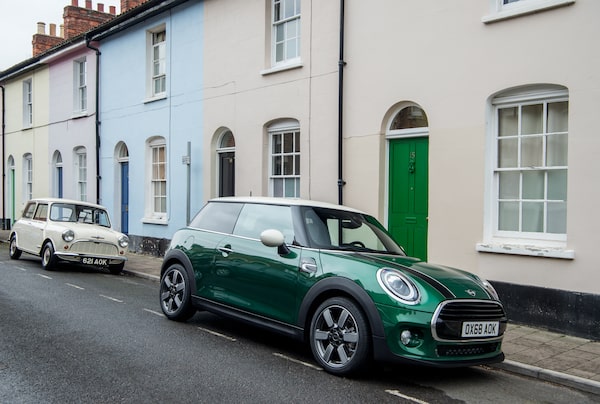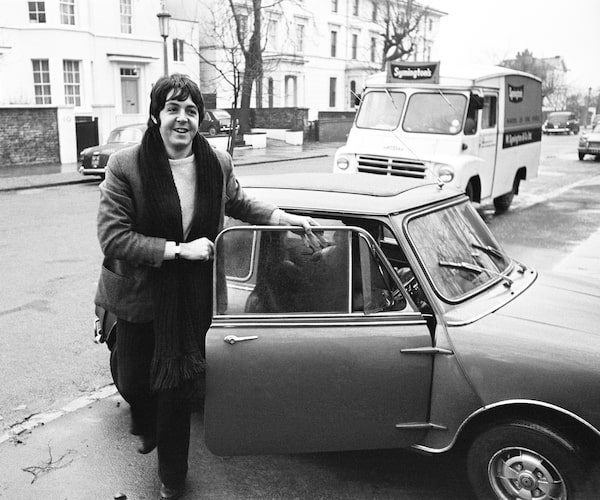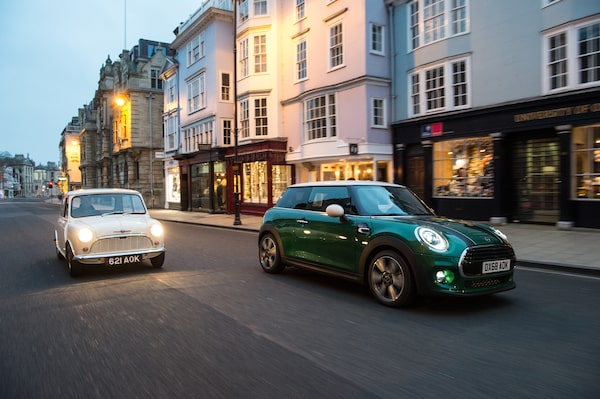
The 2019 Mini 60 Years Edition celebrates the iconic brand's long history, which started in response to the high fuel costs that resulted from the Suez Canal crisis.Handout
Here in Britain, it seems you can’t even glance at the road without seeing a Mini. They’re everywhere. Mini Cooper, Mini Countryman, Mini Clubman, coupe or convertible, front-wheel-drive or all-wheel-drive, three-door or even six-door with every combination in between.
“It’s like every other car’s a Mini, isn’t it?” said my aunt, suddenly noticing the little car’s prevalence. Which she did because my aunt, who is not a car person, was sitting in a Mini at the time.
Not just any Mini, but the special edition 60th anniversary Mini, parked in her driveway after a run to the shopping centre. She was in the front passenger seat while my wife was squeezed into the rear, and my aunt was thinking about the Minis of her day, back when I was a kid.

The anniversary edition sells in Canada for about $5,000 to $7,000 more than the cost of a regular Mini Cooper or Cooper S.Richard Newton/Handout
Those original Minis, first built in 1959 as a British reaction to the high fuel prices spurred by the Suez Crisis, were apparently designed to fit in a box 10 feet by 4 feet by 4 feet (3 metres by 1.2 metres x 1.2 metres). These modern Minis are bigger because that’s how we like them now. The smallest three-door is 3.84 metres long, and they stretch all the way to the 4.31 metres of the Countryman, which is known, unofficially, as the Maxi.
We’re in the smallest three-door, and my very British aunt is waxing nostalgic for the 1960s. The original Mini was a pretty basic vehicle back then: room (just) for four close friends, and a tiny little trunk with its hinge at the bottom rather than the top. This allowed the trunk to be folded down and left open when extra cargo space was needed. Space inside was expanded by having 10-inch wheels pushed to the far corners, and even sliding windows that allowed thinner doors, widening the interior.

Lord Snowden and Princess Margaret driving home in a Mini in 1965.Douglas Miller/Handout

Paul McCartney of the Beatles with his Mini in 1967.Mirrorpix/Handout
That early Mini was popular, but sales really took off when the Beatles, London supermodel Twiggy, and Princess Margaret and Lord Snowden, among many others, were seen in Minis. Its “go-kart handling” won rallies throughout the sixties and was promoted in the 1969 movie The Italian Job. Its all-round cuteness and quirkiness set it apart from more conventionally sized cars.
Eventually, however, time ran out on its rudimentary engineering and tiny size, and the “classic” Mini was discontinued in 2000. More than five million had been sold, mostly in its first 20 years of production. But BMW owned the rights to the Mini name and design through its control of the Rover Group, and its engineers set about creating a new Mini.

Minis of all kinds are prevalent on the streets of Britain.Richard Newton/Handout
That rebirthed car appeared the following year as a 2002 model and was totally redesigned. It kept some of the funky features, such as the large, round speedometer in the centre of the dash with toggle switches underneath, and it added fun features to make the car seem friendly and fresh. It was an immediate hit. It helped that The Italian Job was remade in 2003 and showed the little cars in a sexy new light.
The “new” Mini Cooper is now in its third generation, but sales have slipped recently. In the past year, as of September, sales around the world dropped 1.8 per cent to 261,000 vehicles. In Canada, sales dropped 12 per cent, to 4,655 cars. Such peaks and troughs are not uncommon, though, as buyers wait for new models to be introduced. There’s already a plug-in hybrid Mini Countryman available, and an all-electric Mini Cooper will be introduced in Europe next month.
The interior of the anniversary edition marks it as a clearly premium trim.mark richardson/The Globe and Mail
My aunt, however, is more preoccupied with this 60th anniversary Mini, which sells in Canada for about $5,000 to $7,000 more than the cost of a regular Mini Cooper or Cooper S, which normally starts at $23,000 and rises to the low $30,000s. It has “60th” badges inside and out, and is clearly a premium edition, with soft leather seating and a pinstriped front fascia. There’s an impressive LED puddle light that projects the logo on the ground when you open the doors, and the 17-inch wheels are way larger than those 10-inch originals. But it’s the colour that’s most important: British Racing Green, with twin hood stripes. Back in the day, all British race cars were green, so Minis had stripes on them to make them stand out on the track.
Those early Minis were immediately successful as rally cars, owing to their peppy little engines, light weight and the pushed-out wheelbase. British race car maker John Cooper began tuning them in 1961 and his versions became the Mini Cooper; today, the John Cooper Works Minis are the most powerful editions, creating more than 300 horsepower from their twin power turbo engines – more than twice the output of a base 134 hp Cooper. The JCWs are not Mr. Bean cars.

The twin hood stripes are a callback to the Mini's rally heritage – they were added to race vehicles to make them stand out from the pack.Richard Newton/Handout
Aunt Diane’s husband, my uncle Bill who died 20 years ago, was a keen rally driver in his day, but he never raced Minis. At well over six feet tall, he just couldn’t fit in them. “I think he’d fit in this one though,” Diane said, stretching her legs out while my wife pulled in hers behind. “I think he’d do everything he could to fit himself in. Does the top come off?”
It does, but not on the 60th anniversary specials. They’re only available as three-door or five-door hardtops. This three-door has enough space for the three of us with some room to spare for a fourth person, but even so, Diane got out of the Mini and let my wife stretch her legs. She stood in the driveway and just looked for a while at the car parked there, something she’s never felt inclined to do before.
“Can you leave it here for a few days?” she asked. “Bill would have been so proud.”
Mini invasion

More than 300 'Miniacs' headed to Ontario's Prince Edward County for the fifth annual Mini Invasion.Lucas Scarfone
More than 300 Minis came to Ontario’s Prince Edward County this month for the fifth annual Mini Invasion. It was a weekend for their owners to meet and geek out on all the little cars.
Guest of honour was Charlie Cooper, the 38-year-old grandson of John Cooper, whose name is on the back of most of the cars. He’s a brand ambassador for Britain-based John Cooper Works and he races in the Mini Challenge Championship.
“There’s no other car that makes people smile as much as a Mini,” he says. “Whether you look at it, or drive it, there’s just something special about it. You’re part of a community, and it’s a special brand.”
All the “Miniacs” at the Invasion agreed. The sense of fun was everywhere, and many of the cars showed this with their licence plates: FUNSIZE from Quebec, MIN MIN from New Brunswick, even ZOOOOP from Connecticut.

The fun was pervasive at the Invasion.Lucas Scarfone
“I didn’t really understand until I drove one in 2014. Something came over me – I guess a subconscious smile,” says Omer Humayun, a retired bus driver from Ottawa. “Then I found the club culture and I realized it came with a family. I guess I like the car not so much as a machine but for the people who come with it.”
His 2005 Cooper S convertible has a huge sticker on the side that says “Save the Wave.”
“Part of the rules of Mini culture is that you have to wave at other Minis, but the less ‘Mini’ the Mini becomes, it seems that the culture of waving is disappearing,” he explains. “There are more and more of them on the road. I’m hoping this will let owners know they’re supposed to wave at other Minis.”
John Hollands and Stéphanie Darras say they waved at every Mini they saw on the drive from Montreal. They work for Mini Brossard, a dealer in Quebec, and came down in a big Countryman and a tiny 1977 Classic Austin Mini 1000.

Charlie Cooper, the 38-year-old grandson of John Cooper, says, 'There’s no other car that makes people smile as much as a Mini.'Lucas Scarfone/Handout
“You can expect anything with a 40-year-old British car,” Hollands says. “We know she’s in good nick mechanically, but we have to keep an eye on her. It’s not a restored vehicle, so we just keep it running and fix it as it goes along.”
It’s gaining in value, he says, as American collectors seek out Classic Minis. “The baby boomers in the States are looking for the original Cooper Sʼs from the sixties, and they’re what’s guiding the market right now. Those Cooper Sʼs are selling now for US$60,000-$70,000 and that’s influencing the value of the regular Minis.
“Maybe five years back, you could buy one like ours for maybe five grand, and now they’re asking 15 [thousand] for the same car. They’re actually a good investment.”
Stay on top of all our Drive stories. We have a Drive newsletter covering car reviews, innovative new cars and the ups and downs of everyday driving. Sign up today.
Shopping for a new car? Check out the new Globe Drive Build and Price Tool to see the latest discounts, rebates and rates on new cars, trucks and SUVs. Click here to get your price.